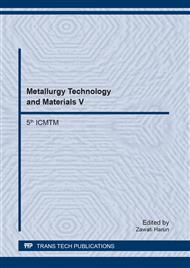p.142
p.146
p.151
p.157
p.162
p.167
p.174
p.179
p.185
Influence of Pretreatment on the Free CaO in Steel Slag
Abstract:
An experimental program was carried out to investigate how to improve the characteristics of steel slag. Mainly the pretreatment methods of cooking and autoclave were used to detect such as free CaO content in the steel slag. The physical and chemical characteristics of steel slag were measured by X-ray diffraction (XRD) and fluorescence (XRF) analysis. The aim of improving the slag utilization is an important way to resolve large production problem, and then the research progress of steel slag utilization at home and abroad are recycled as raw material to be applied. By means of those ways to manage steel slag we have received the following conclusions: With the increase of cooking temperature the content of free CaO is gradually reduced. When temperature higher than 90oC the means could greatly reduce the free CaO content from about 7% wt. to less than 2.5% wt. in 3 h. By means of autoclave pressure upto 1.5MPa could greatly reduce the free CaO content from about 7% wt. to less than 3.2% wt. in 3 h. Through the study of the relevant of steel slag after pretreatment can effectively reduce the free CaO content in the steel slag, improving the stability of the steel slag is advantageous to the seven used in the construction field.
Info:
Periodical:
Pages:
162-166
Citation:
Online since:
August 2017
Authors:
Keywords:
Price:
Сopyright:
© 2017 Trans Tech Publications Ltd. All Rights Reserved
Share:
Citation:


